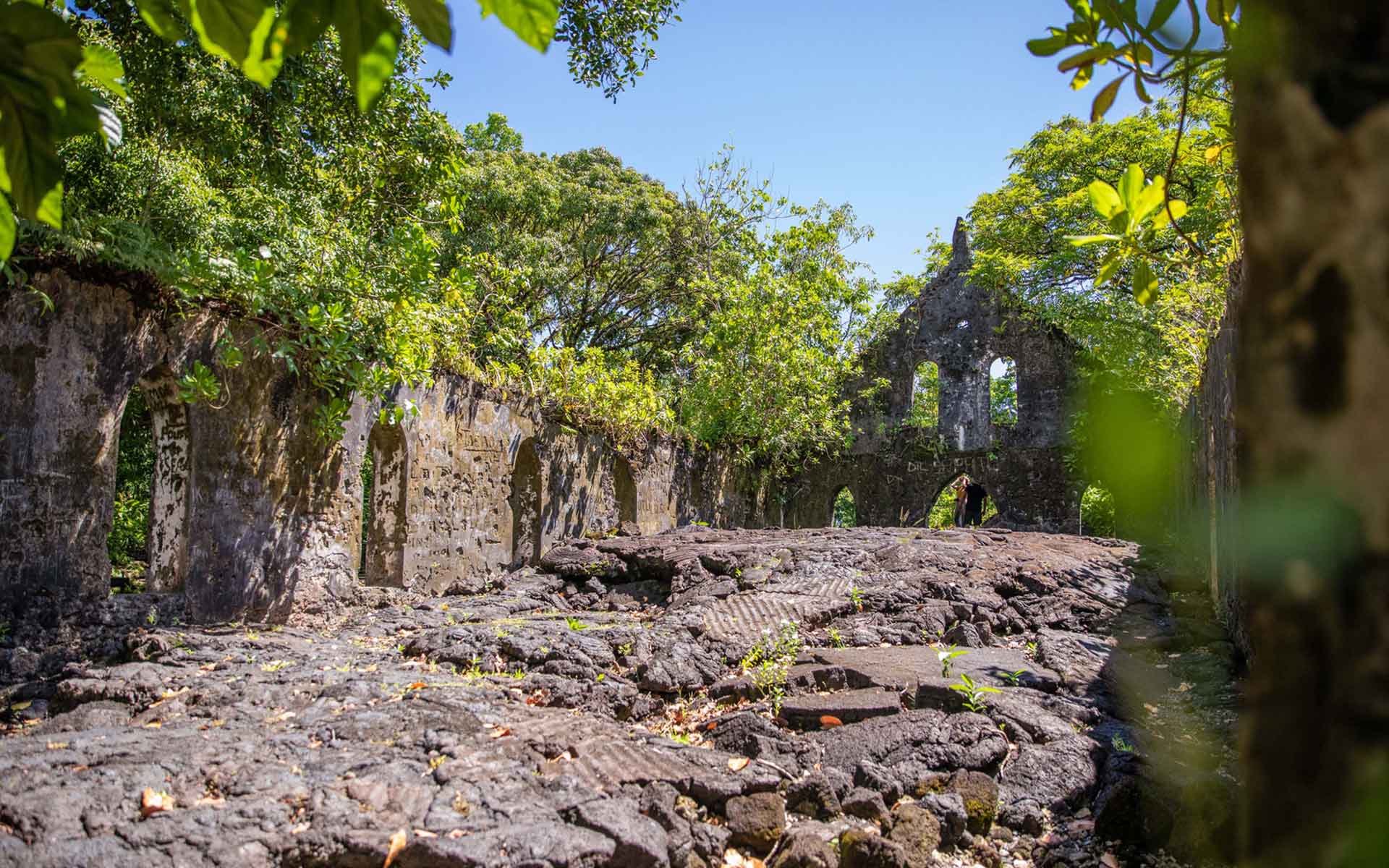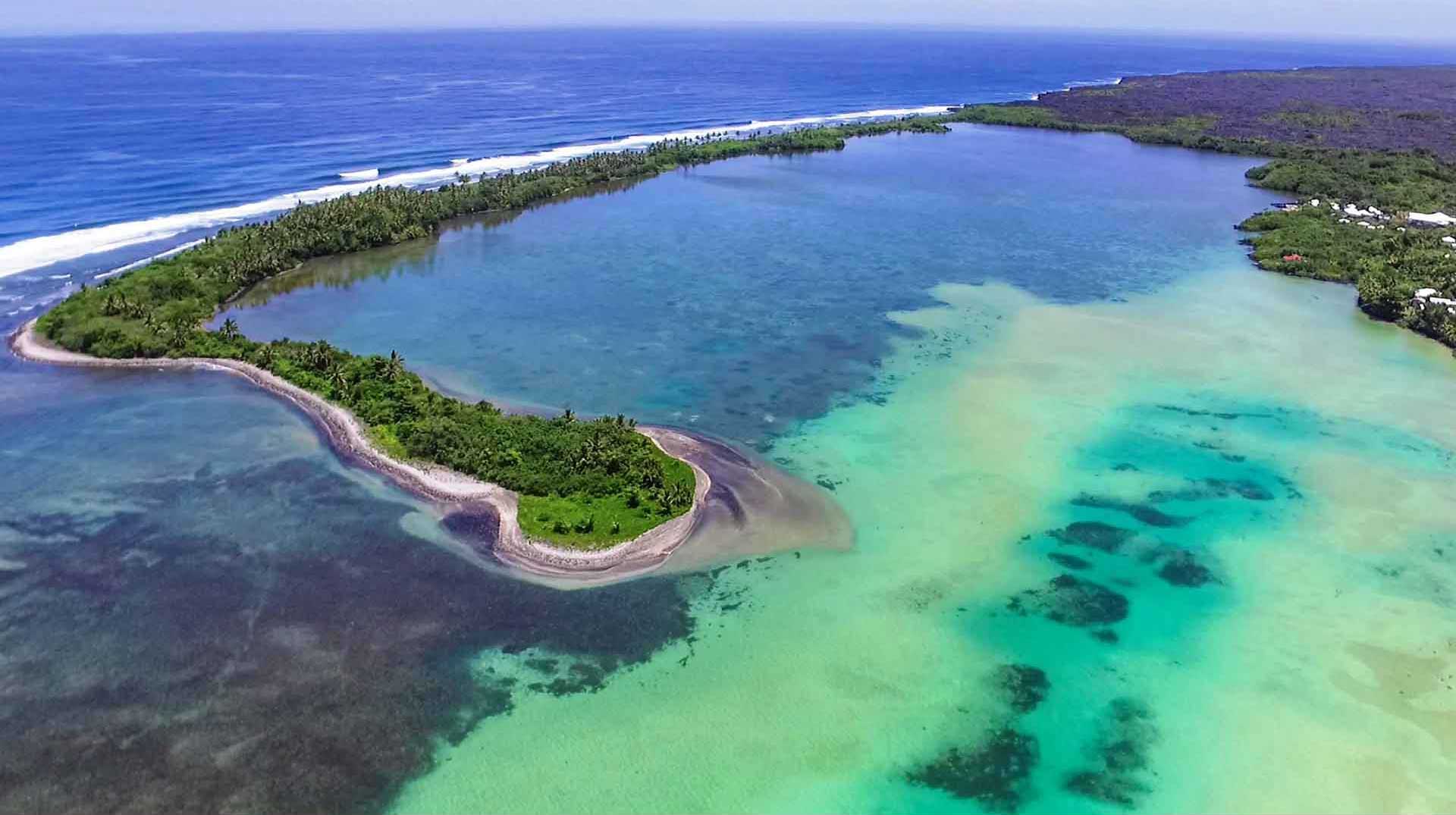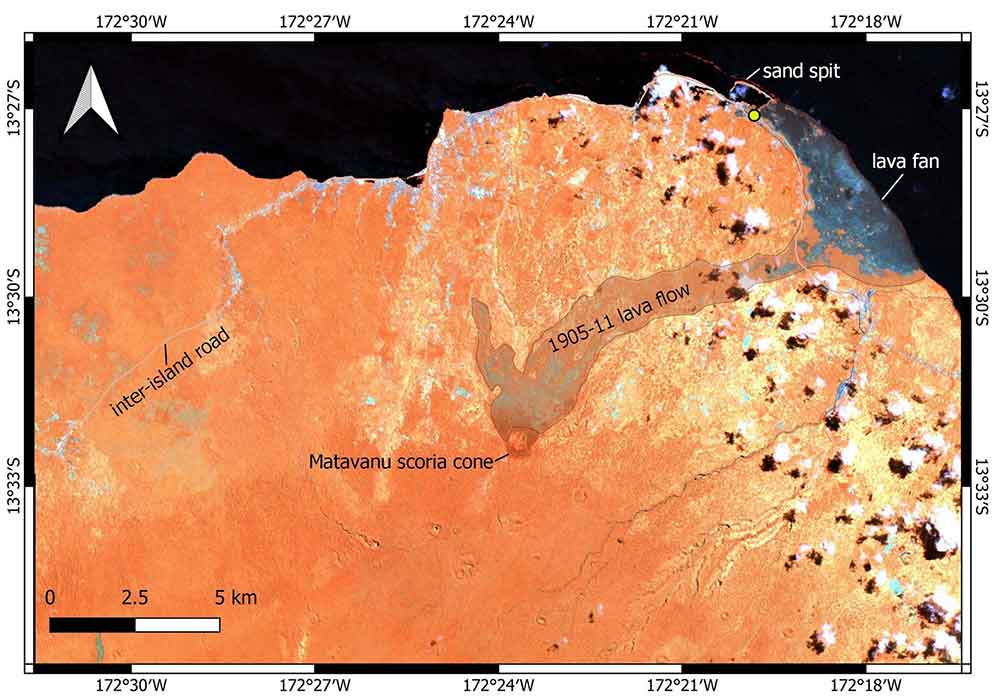
Pahoehoe lava flow from the 1905-11 Matavanu eruption inside the ruins of the London Missionary Society Church of Saleaula. (Samoa Tourism Authority).
Geological Period
Holocene
Main geological interest
Volcanology
Location
Matavanu, Savai’i island. Samoa, SW Pacific.
13°32’17.0″S, 172°23’38.0″W
Pahoehoe lava flow from the 1905-11 Matavanu eruption inside the ruins of the London Missionary Society Church of Saleaula. (Samoa Tourism Authority).
One of the best examples in the SW Pacific of an oceanic hot spot and its early 20th-century eruption.
The Matavanu 1905 – 1911 eruption is the youngest volcanic eruption in Samoa and as such it is a global example of oceanic hot spot volcanism and of a Pacific Island chain. This eruption destroyed a local village and originated an extensive lava flow field that expanded the landmass of Savai’i Island. The Matavanu volcano and near-by faults associated with the slumping of northern Savai’i Island are related to the volcano-tectonics of the island.
- Geological description
The Samoan Islands have a record of ~2 million years of hot spot volcanism (Kear and Wood, 1959), culminating in historic eruptions at both the east and western ends of the volcanic island chain, including a major lava- producing episode in Savai’i Island during the 1905–1911 Matavanu eruption (Anderson, 1910). This eruption covered large coastal plains in NE Savai’i, beginning on 4 August 1905 with ash emission from a scoria cone, followed by lava flows that reached the sea producing steam explosions at the flow front in early 1906 (Anderson, 1910). With the development of the lava field, much of the lava flowed through tubes. Several lava benches collapsed into the sea generating local tsunamis with 2–2.5 m waves in late 1906 and throughout 1907. Four settlements and one major village (Sale’aula) were destroyed by lava. The walls and upper parts of two stone churches are the sole remnants. Displaced communities were relocated to a new village called Salamumu (meaning “fire punishment”) (Fepuleai et al., 2017). The eruption was a significant event in Samoan history and is a powerful reminder of potential volcanic hazards in Savai’I (Fepuleai et al., 2021). Numerous textbook features are conserved and easily accessible, including craters, pahoehoe and aa flows, tumulus, lava tubes (with associated blowholes) and a post-eruption volcaniclastic-carbonate spit (Németh and Cronin 2009; Németh et al., 2017).
- Scientific research and tradition
Scientific literature is scarce but recent interest in geoconservation and establishing a geopark ignited a new wave of volcanology and geocultural research.
- Reference
Anderson, T. (1910) ‘The Volcano of Matavanu in Savaii’, Quarterly Journal of the Geological Society, 66(1–4), pp. 621–639. Available at: https://doi.org/10.1144/GSL.JGS.1910.066.01-04.30.
Fepuleai, A. et al. (2017) ‘Eruption Styles of Samoan Volcanoes Represented in Tattooing, Language and Cultural Activities of the Indigenous People’, Geoheritage, 9(3), pp. 395–411. Available at: https://doi.org/10.1007/s12371-016-0204-1.
Fepuleai, A., Németh, K. and Muliaina, T. (2021) ‘Geopark Impact for the Resilience of Communities in Samoa, SW Pacific’, Geoheritage, 13(3), p. 50. Available at: https://doi.org/10.1007/s12371-021-00578-4.
Kear, D. and Wood, B.L. (1959) The Geology and hydrology of Western Samoa. (New Zealand Geological Survey Bulletin, 63).
Németh, K. and Cronin, S.J. (2009) ‘Volcanic structures and oral traditions of volcanism of Western Samoa (SW Pacific) and their implications for hazard education’, Journal of Volcanology and Geothermal Research, 186(3), pp. 223–237. Available at: https://doi.org/10.1016/j.jvolgeores.2009.06.010.
Nemeth, K., Fepuleai, A. and Muliaina, T. (2017) ‘Samoa Geopark Project: a strategic plan to promote the volcanic geoheritage of Savai’i Island, Samoa’, in STAR 2017 – The Pacific Islands Science, Technology and Resources Conference. Nadi, Fiji. Available at: https://doi.org/10.13140/RG.2.2.19607.68009.
- Author(s)
Károly Németh
Massey University, New Zealand; Institute of Earth Physics and Space Science, Hungary and Saudi Geological Survey, Kingdom of Saudi Arabia
Lameko Talia
Ministry Natural Resources and Environment, Samoa
Katie Pogi
Ministry of Natural Resources and Environment, Samoa
Aleni Fepuleai
Blaqsand Enterprise, Samoa
Gary Lee
The Pacific Community (SPC), Fiji
Dana Tigarea
The Pacific Community (SPC), Fiji
Benjamin van Wyk de Vries
Université Clermont Auvergne, Laboratoire Magmas et Volcans, OPGC, CNRS et IRD, Clermont Ferrand, France


